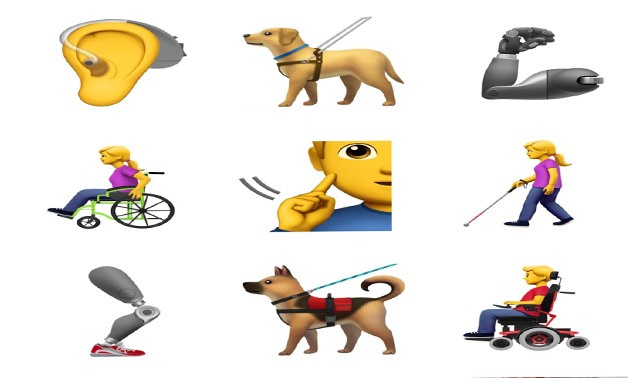
Courtesy of Unicode
CAIRO – 24 March 2018: Apple Inc. submitted a proposal to the Unicode Consortium, the organization that reviews requests for new emoji characters, requesting the introduction of new emoji to better represent the experience of persons with disabilities and help fill a significant gap in this area.
In its proposal, the company explained, “Currently, emoji provide a wide range of options, but many do not represent the experiences of those with disabilities.” In the current set of emojis, there is just one character that represents disability – “a wheelchair-user sign” – that is often used as an accessible toiler sign.
Apple also said that emoji are a universal language and powerful form of self-expression that can represent the user’s own personal experience as well as their support for a loved one. In 2016, some disability charities advocated for developing emoji to represent persons with disabilities. The charities explained that there is an increased representation of women and races in emoji, but still persons with disabilities are missing. Celebrating World Emoji Day on July 17, the U.K.-based disability charity “Scope released in 2016 a set of 18 emoji featuring disabled persons and Paralympics sports. The charity also criticized the emoji update during the 2016 Rio Olympics, as it included medals and sports commemorating only the Olympics, while there was no recognition of the Paralympics.
Emojipedia announced Apple’s proposal through its official Twitter account and said that if the emojis are approved, they will be on phones next year.
The company thinks that the 13 proposed new emojis would make technology more accessible to persons with disabilities and would help foster a diverse culture that is inclusive of disability. The proposed emojis represent different skin tones and both genders; they include:
Blind and low vision: 285 million individuals are blind or have low vision worldwide. In addition to the existing magnifying glass and eye emoji, Apple proposes adding characters of persons walking with canes and service dogs in reference to trained dogs that help those with hidden disabilities.
Deaf and hard of hearing: 360 million individuals are deaf or hard of hearing. Apple proposes adding characters of persons signing that they are deaf (amongst 31 global sign languages, 18 use the index finger gesture to represent the deaf sign) and an ear with a hearing aid.
Physical and motor skills: The proposed characters include persons in manual and mechanical wheelchairs, and another character of prosthetic limbs.
Apple explained in its proposal to Unicode, “This new set of emoji that we are proposing aims to provide a wider array of options to represent basic categories for people with disabilities. This is not meant to be a comprehensive list of all possible depictions of disabilities, but to provide an initial starting for greater representation for diversity within the emoji universe.”
According to the company’s proposal, one in seven people around the world has some form of disability, whether that be a physical disability involving vision, hearing or loss of physical motor skills, or a more hidden, invisible disability.
“For this proposal, we have selected a set of emoji that are most inclusive to a large number of people in four main categories: Blind and Low Vision, Deaf and Hard of Hearing, Physical Motor, and Hidden Disabilities. Developed in collaboration with internationally respected community organizations such as the American Council of the Blind, the Cerebral Palsy Foundation and the National Association of the Deaf, we believe this proposal is a significant step forward in representing more diverse individuals, and we hope it will spark a global dialogue around better representation for people with disabilities,” read Apple’s proposal to Unicode.
Twitter users welcomed Apple’s initiative and expressed that it would support persons with disabilities.
Meanwhile, others expressed concern that there is a chance that people would misuse these emoji.
And others were totally against the idea, as they think it reminds people of their disability

Comments
Leave a Comment